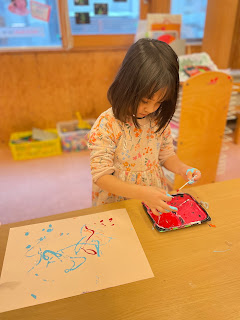19: Perspective
It's not only moving that creates new starting points. Sometimes all it takes is a subtle shift in perspective, an opening of the mind, an intentional pause and reset, or a new route to start to see new options and new possibilities.
What do you see when you look at this picture?
In the story of The Little Prince by Antoine de Saint-Exupery, many people see it as a hat when it is actually meant to be a boa constrictor that swallowed an elephant.
Perspective is a powerful concept that changes how we navigate the world. Apart from its importance in helping us deepen our relationships and bridge cultures, perspective also allows us to think outside the box. Whether we see the drawing as a hat or a boa constrictor, it's okay because the way we see the world is different from each other.

What did you paint?
It’s a forest. The forest has a lot of trees. There are dinosaurs in the forest. The dinosaurs are finding humans.
What does your painting make you feel?
My painting makes me feel happy. I like dinosuars. My favorite one is the T-Rex.
EMMA
What did you paint?
I painted a lot of flowers. It’s in a garden. There are blue, yellow, green, and pink flowers. It’s Hana’s garden.
What does your painting make you feel?
My painting makes me feel happy because I like Hana. I also like gardens. Hana and I planted the flowers together. We live in the same house.
What did you paint?
I painted a swirl in the sky. It’s like the wind. A very strong wind. It is blowing a lot of things.
What does your painting make you feel?
My painting makes me feel happy. It makes me feel happy because it’s colorful.
CHANIN
What did you paint?
I painted snow. There’s a lot of snow on the ground. It was a sunny day.
What does your painting make you feel?
My painting makes me feel happy. It makes me feel happy because I love snow.
SARAH
What did you paint?
I painted colorful snow. It’s like rainbow snow.
What does your painting make you feel?
My painting makes me feel happy because I love snow. I love rainbows too. Rainbow snows are beautiful.
What did you paint?
I painted a potato. The potato is in the onsen. The water cooked the potato. Ms. Pam ate the potato after.
What does your painting make you feel?
My painting makes me happy. I like the colors that I used, especially red. Pink and yellow too.
TAMAKI
What did you paint?
I painted some stars. I painted the triangles. They are like trees. I also painted some clouds.
What does your painting make you feel?
My painting makes me feel happy. It was so fun to make my painting.
KALLEA
What did you paint?
I painted a rainbow. I mixed the colors to make the rainbow.
What does your painting make you feel?
My painting makes me feel happy because rainbows make me happy. I love rainbows because they have many colors.
What did you paint?
I painted the nighttime. I am looking out the window. I see meteors in the sky. I feel happy.
What does your painting make you feel?
My painting makes me feel like I am in the painting. It makes me feel happy.
What did you paint?
I painted a lot of lines. I love line drawings. Lines are beautiful. The lines remind me of hair — my sister’s hair. My sister’s hair is so beautiful.
What does your painting make you feel?
My painting makes me feel happy. I think my painting looks beautiful.
HARUTO
What did you paint?
I painted nighttime. The yellow ones are the stars. The peach color is a scary house.
It has a ghost.
What does your painting make you feel?
My painting makes me feel surprised. The ghost in the painting surprised me.
What did you paint?
I painted many circles. They are different fish. Some are small, some are very big. Fish make me feel curious. I want to learn about them.
What does your painting make you feel?
My painting makes me feel excited. I want to get fish toys just like the fish in my painting.
KOH
What did you paint?
My painting is a swimming pool. I like swimming. My painting is like a map of my house going to the pool. I can also see my grandpa’s house.
What does your painting make you feel?
My panting makes me feel happy. I love painting. Swimming makes me happy, too.
ZOEY
What did you paint?
My mommy. My mommy makes me feel happy too.
What does your painting make you feel?
My painting makes me feel happy. It makes me feel happy because of the colors.
"Learning is often a messy business. Messy learning is part trial and error, part waiting and waiting for something to happen, part excitement in discovery, part trying things in a very controlled, very step by step fashion, part trying anything you can think of no matter how preposterous it might seem, part excruciating frustration and part the most fun you’ll ever have. Time can seem to stand still – or seem to go by in a flash. It is not unusual at all for messy learning to be… um… messy! But the best part of messy learning is that besides staining your clothes, or the carpet, or the classroom sink in ways that are very difficult to get out … it is also difficult to get out of your memory!"
Have a look at the unforgettable memories that we made this week:
































































They enjoyed expressing themselves. I like their colourful pictures. Thank you so much.
ReplyDelete